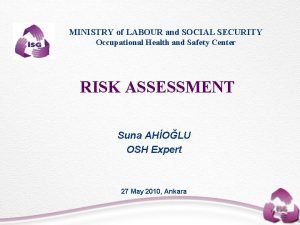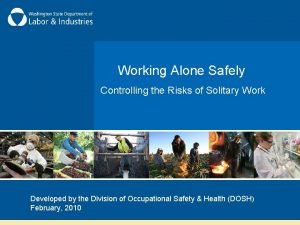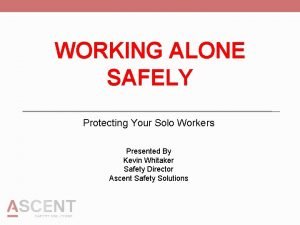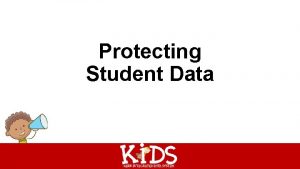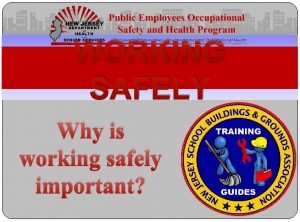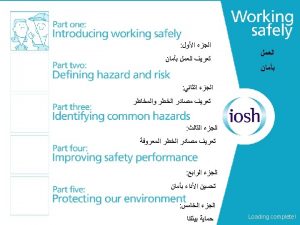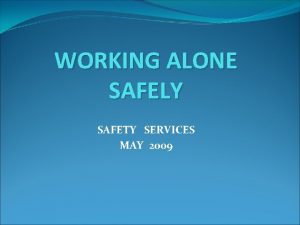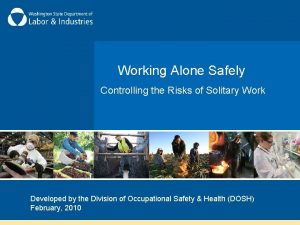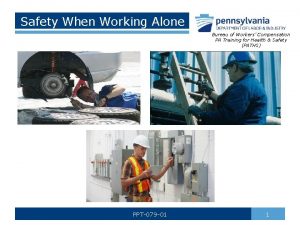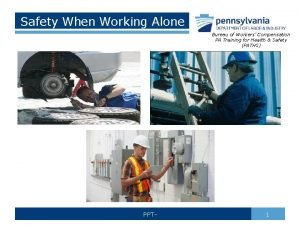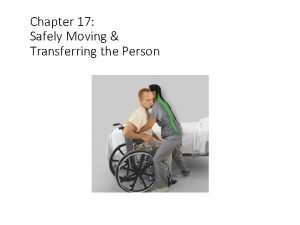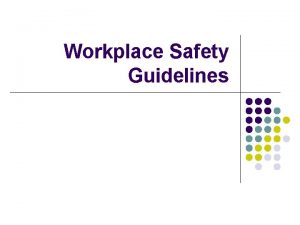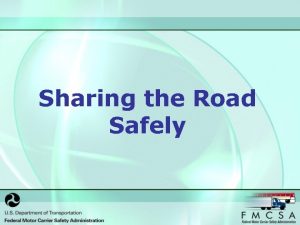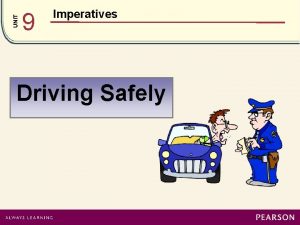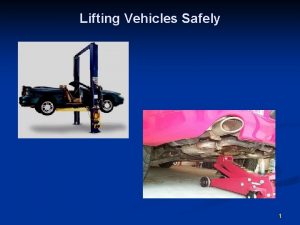WORKING ALONE SAFELY Protecting Your Solo Workers Presented




















- Slides: 20

WORKING ALONE SAFELY Protecting Your Solo Workers Presented By Kevin Whitaker Safety Director Ascent Safety Solutions

WORKING ALONE SAFELY Objectives • Recognize situations where you may be working alone. • Understand risks and circumstances that increase your risk of working alone. • Develop safety guidelines for controlling risks of working alone. • Realize that safety should be a constant.

WORKING ALONE SAFELY Definition “Employees that: • work by themselves • without direct or close supervision • without contact with other employees • for an extended period of time. ”

WORKING ALONE SAFELY The only difference is no one is watching out for or over you.

WORKING ALONE SAFELY 1. 2. 3. Job Hazard Analysis Develop a list of situations where you have worked alone. Add a column of tasks and risks associated to your situations List avoidance techniques you can use to minimize risks

WORKING ALONE SAFELY EXPOSURES • Employee • Environment • Equipment • Materials • Accessibility

WORKING ALONE SAFELY Employee Exposures • Condition • Physical • Mental • Fatigue • Capacity and skill • Experience • Under the influence • Complacency • Convenience • Lack of focus or attention

WORKING ALONE SAFELY Environmental Exposures • Weather • Atmosphere • Lighting • Noise • Job site • Nature of your job tasks • Contractor’s safety culture

WORKING ALONE SAFELY Equipment Exposures • Meets Applicable Standards • Current Condition • Maintenance • Application to your job • Ergonomic Considerations • Operational and Safety Training • Responsibility for equipment

WORKING ALONE SAFELY Material Exposures • Chemicals • Tools • Elevation devices • Electricity • Pressure vessels • Stored energy sources

WORKING ALONE SAFELY Accessibility • Site Ingress • Specific work area • Access by non essential people • Emergency access • Site Egress

WORKING ALONE SAFELY RISK REDUCTION EQUIPMENT • Cell phone or other communication tool • Personal Protective Equipment • First aid kit • Insect/dog repellent • Gas monitors • Flashlight/matches

WORKING ALONE SAFELY Safety Tips for Traveling • • • Ensure someone knows your schedule and locations Dress and behave conservatively Take only essential valuables Avoid routine patterns Assess parking, walking

WORKING ALONE SAFELY Safety Tips for Traveling (continued) • Locate exits and stairwells • Stay at least one story above ground • Meet with designated persons only • Ask for photo ID • Pay attention when walking and driving • Use three times rule – Three contacts separated by time and distance

WORKING ALONE SAFELY RISK EVALUATION • • • Exposures Frequency/duration of exposures Potential injuries Number of employees exposed to risks Proximity of assistance

WORKING ALONE SAFELY Minimizing Risks • Can one employee do the job safely? • Fitness level of employee? • Has the employee been trained? • Does employee understand job and risks? • What is the threat of violence? • Need for periodic contacts? • Additional risk to women and teens?

WORKING ALONE SAFELY Periodic Contacts • Schedule sharing • Camera systems • 2 -way radio, beepers • Cell phones • Hard wire phones • Supervisor visits • Buddy system • E-mail

WORKING ALONE SAFELY Innovative Ideas • Supervisor evaluates jobsite with employee prior to any lone visits. • Lab simulated work alone situations to observe/modify employees behaviors. • Regular personal safety perception surveys. • Regular, focused safety communications by safety department which elicits feedback from employee.

WORKING ALONE SAFELY The only real difference between normal work situations and working alone is the lack of someone watching over you. Safety is a part of every job.

QUESTIONS? Kevin Whitaker Ascent Safety Solutions kwhitaker@ascentsafetysolutions. com www. ascentsafetysolutions. com
 Que es la oracion
Que es la oracion Obtaining and protecting your credit vocabulary check
Obtaining and protecting your credit vocabulary check Chapter 9 obtaining and protecting your credit
Chapter 9 obtaining and protecting your credit Chapter 9 obtaining and protecting your credit
Chapter 9 obtaining and protecting your credit Working alone risk assessment example
Working alone risk assessment example Ccohs working alone
Ccohs working alone Safety tips for working alone
Safety tips for working alone Smart vs hard working
Smart vs hard working Cold working of metals
Cold working of metals Hot working and cold working difference
Hot working and cold working difference Machining operations
Machining operations Proses pengerjaan panas
Proses pengerjaan panas Chapter 20 civil liberties protecting individual rights
Chapter 20 civil liberties protecting individual rights Reactions of aldehydes and ketones summary
Reactions of aldehydes and ketones summary Primary aldehyde
Primary aldehyde Carbamate protecting group
Carbamate protecting group Hale quotes act 1
Hale quotes act 1 Protecting student data
Protecting student data Protecting consumers savers and investors examples
Protecting consumers savers and investors examples Which of the following is not part of overall biodiversity?
Which of the following is not part of overall biodiversity? Species diversity
Species diversity




